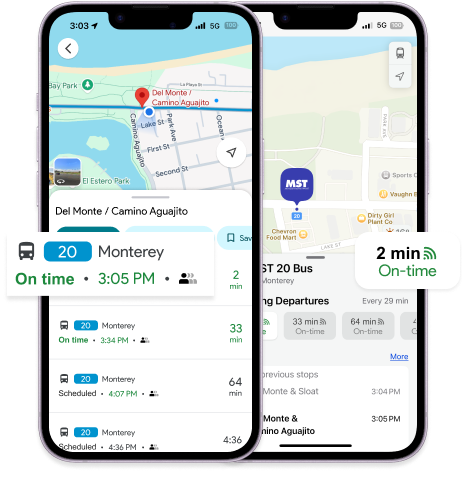Introduction to GTFS
Everything you need to know
Where is my bus? Real-time data is how both riders and operators answer this question. GTFS allows you to see your vehicle—in real time, on a map.
So, what exactly is GTFS?
GTFS feeds allow public transit agencies to share their transit data, making it easier for developers to create applications that can use this information effectively. Transit service providers produce schedules and prices; third-party applications (like Google Maps, Transit App, etc.) consume this data. Riders use this data to plan for their transit trip.
There are two main components: Schedule and Realtime. GTFS Schedule is the plan of what transit service looks like; GTFS Realtime is what is actually happening with the transit service.
GTFS Schedule
- Static information
- Describes the routes and schedule of a transit agency
- Establishes the baseline transit information
GTFS Realtime
- Dynamic information
- Describes the location of vehicles in real time
- Adjusts transit information based on real-time updates
GTFS Schedule is the backbone of transit data. GTFS Schedule and GTFS Realtime depend on each other. GTFS Realtime needs GTFS Schedule to give it the baseline operations assumptions. It then enhances this data by adding in real-time data.
They each provide comprehensive information in a standardized format.
GTFS Schedule Data
- Routes
- Stops
- Day and time schedules
GTFS Realtime Data
- Vehicle location
- Updates
- Alerts (detours, holidays, etc.)
Because GTFS is standardized, you can easily integrate your data with third party applications and build on top of it with other vendors.
Power of GTFS Realtime
Enhancing rider experience & operational efficiency
For transit riders, knowing when a bus or train will actually arrive reduces uncertainty, increases the attractiveness of transit, and improves rider satisfaction.
For operators, real time brings operational insights and supports the ability to dispatch vehicles in emergencies.
Meet your riders on the apps they already use
Real-time transit data comes in many forms but only one—the General Transit Feed Specification (GTFS)—provides a universal template that is compatible regardless of who produced it or who wants to use it.
That means that no matter who your GTFS vendor is, common third-party transit apps like Apple Maps, Google Maps, and Transit App can use it.
With GTFS, you can meet your riders where they are, no need to download a special app; they will be able to see transit options in apps they already use.

By the numbers
NYC & ChicagoBus ridership increased by 2% after transit agencies published real-time arrival information
SeattleRiders perceived wait times to be 30% shorter when they had access to GTFS Realtime data
How do I get GTFS?
You can create GTFS Schedule with a planning and scheduling software. If your agency has received 5311 funding in the last 3 years, you may be eligible for a free Remix license provided by CalSTA and Caltrans. Remix is a comprehensive transportation planning and scheduling software tool.
You can adopt GTFS Realtime with your own hardware or purchase directly from vendors via MSAs (Master Service Agreements). California DGS competitively awards contracts or MSAs to vendors offering standardized GTFS Realtime products.
GTFS Schedule with Remix
You may be eligible for a free Remix license from CalSTA and Caltrans. Fill out the application form.
GTFS Realtime with MSAs
California DGS competitively awards MSAs to vendors offering GTFS Realtime products.
Quality GTFS Schedule leads to Quality GTFS Realtime
Caltrans developed the California Transit Data Guidelines to help ensure transit data meets riders’ expectations. The Guidelines address several key features:
- Publication of GTFS Schedule and Realtime data, including service alerts and accessibility info
- Availability of GTFS feeds on open-source feed aggregators, with an open data license
- Real-time data feeds (APIs) with an uptime greater than 99%
- Designation of a single point of contact at each transit agency
- A documented process for improving data quality and supporting processes and technology
Caltrans can help monitor your GTFS quality to support your service
Caltrans’ Data Quality Team can help ensure that your data is high quality and able to get you the best results possible.
We can help you monitor your GTFS Schedule and GTFS Realtime feeds for errors and provide guidance on how to resolve them. We also provide monthly data quality reports with key metrics to help you understand how your data is working for you.
Learn more about data quality at the California GTFS Quality Dashboard or email [email protected] to request a GTFS Data Assessment.
Next steps
- GTFS Schedule ➞ Check your eligibility and apply for a free Remix license.
- GTFS Realtime ➞ Learn more and get started with the MSA contracts.
- Data Quality ➞ Visit California GTFS Quality Dashboard or email [email protected] to request a GTFS Data Assessment.
Whichever option you choose, Cal-ITP is here to offer you technical assistance in rolling out GTFS Schedule and GTFS-RT.
Resources
- Email [email protected] to get started with MSAs, request a GTFS Data Assessment, and more
- Check your eligibility for a free Remix license to create your GTFS Schedule
- Get started with MSA contracts to establish GTFS Realtime
- Obtain a report on the quality of your agency's GTFS data, visit California GTFS Quality Dashboard
- Review Caltrans' standards for high-quality transit data at California Transit Data Guidelines